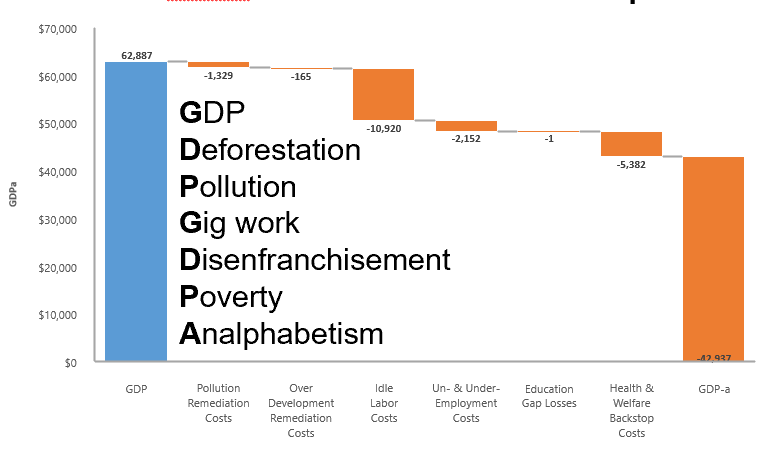GDP-a
Over-reliance on GDP leads to unsustainable decision-making in government and business.
Gross Domestic Product (GDP) is reported quarterly and estimated monthly for every economy in the world. It is the single most watched economic indicator. According to the US Bureau of Economic Analysis, “GDP is watched around the world as an economic barometer. The White House and Congress use GDP numbers to plan spending and tax policy. The Federal Reserve uses them when setting monetary policy. State and local governments rely on GDP numbers, too. Business people use these stats when making decisions about jobs, expansion, investments, and more.”
Yet, GDP, which was developed in 1934 and widely deployed starting in 1944, provides an incomplete picture of economic progress. Over the more than 70 years since its widespread adoption, environmental, social, and labor force issues have become far more complex. GDP can increase while conditions are getting worse for many or even most people. The gap between the economic data reported in the mainstream news on the one hand, and issues that are of personal concern to many people on the other, has widened over many years.
GDP-a addresses environmental, social, and economic factors that GDP ignores.
- GDP ignores the economic cost of environmental externalities such as CO2 emissions, air and water pollution, loss of biodiversity, deforestation, and loss of productive ecosystems. As a result, GDP has generally trended upward while unsustainable side-effects such as climate change have gotten worse because they are ignored in most investing and policy decisions.
- GDP omits the economic cost of social imbalance. Illiteracy, inequality, poverty, criminality, mental health problems, drug abuse, and incarceration all have an economic cost. These problems result at least in part from our economic systems, but because they aren’t measured in any systematic way they largely fester until they rise to the level of social unrest or chaos, evidenced recently by the Black Lives Matter movement.
- GDP does not consider the cost of idle labor, skills mismatches, and poverty. It can increase while unemployment and underemployment rise, while workers are dislocated by economic shifts, and while poverty increases, thereby suggesting policy guidance that ignores these trends.
What is GDP-a ?
GDP-a is a simple calculation that measures “hard” economic costs and is produced on a continuous basis for all countries by the GDP-a Institute. It has seven components:
-
GDP (per capita)
-
Deforestation (Cost of Overdevelopment Remediation)
-
Pollution (Cost of Air, Water and CO2 Pollution)
-
Gig Work (Cost of Idle Labor)
-
Disenfranchisement (Labor Force Non-Participation)
-
Poverty (Cost of Health & Welfare Backstops)
-
Analphabetism (Cost of Under-Education)

Why is GDP-a Better?

Compared to other metrics of sustainable growth, the 24 GDP-a components and 5 related indices are:
- More specific and measurable than the UN’s Sustainable Development Goals
- More quantitative than the Capability Approach
- More balanced than the Measure of Economic Welfare
- More relevant to today’s issues than the Genuine Progress Indicator
- More statistically valid than Gross National Happiness and the Better Life Index
- Simpler to calculate than the Human Development Index, the Gini Index, and others
- Available for all countries and years, unlike the How’s Life Index, Index of Sustainable Economic Welfare (“Green National Income”) and all other metrics except GDP itself

Let’s Work On This Together
Contact us today.